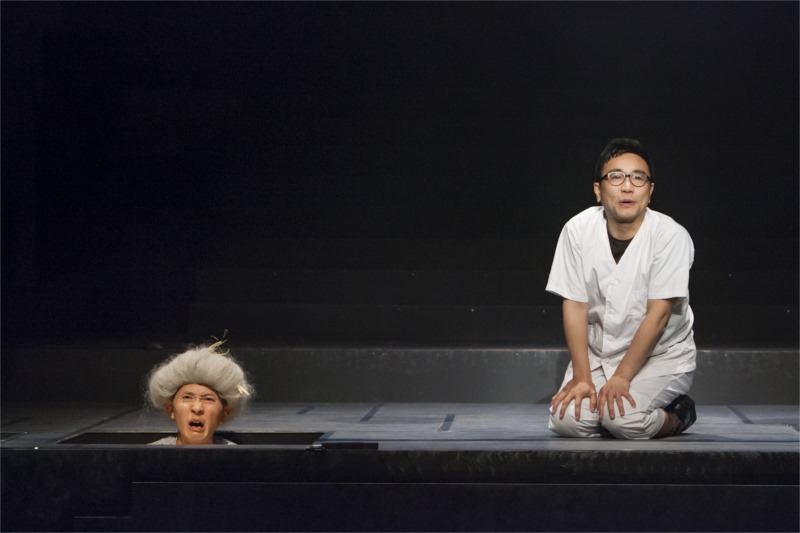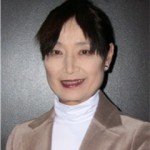Akiko Tachiki[1]

Lemming‒Take me to the End of World レミング~世界の涯まで連れてって(Lemming~Sekai no Hate Made Tsuretette) written by Shuji Terayama, directed by Yukichi Matsumoto, performed at the Parco Theatre, Shibuya, Tokyo, from April 21 to May 16, 2013 on the occasion of Terayama Memorial 30th in Shibuya and as part of the 40th Anniversary of the Parco Theatre.
In 2013, on the occasion of the 30th anniversary of the death of Shuji Terayama (1935~1983), who is one of the most inventive playwrights in the history of Japanese modern theatre, there have been quite a number of new productions of his plays to recognize his contribution. In the 1960s and ‘70s, at the time of a big change in the political and social situation after World War II, Japanese theatre experienced a radical experimentalism to explore the new realm of contemporary theatre. Terayama, as a dramatist, director, poet, and sometimes as a film director, stood on the front line to lead the avant-garde theatre movement, together with such theatrical inventors as Juro Kara (born 1940), Tadashi Suzuki (born 1939) and Makoto Sato (born 1943).
Terayama first specialized in Japanese literature at Waseda University and then left the school before graduating because of illness. He explored the new horizon of theatre by writing innovative, often provocative plays, full of surreal imagination and fantastic satire to show the new potential of theatre. He also opened the door for so-called “city plays;” the concept for these was that the exterior affects and imbues the interior. In 1967, Terayama formed his own theatre group called An Experimental Laboratory of Theatre–Tenjo Sajiki (which literally means “gallery”) inspired by the French film, Les enfants du paradis by Marcel Carne (1945), and made visually rich, energetic theatre. The group had the active participation of artists beyond the artistic boundaries of theatre, such as Tadanori Yokoo, who painted posters of avant-garde design. Terayama and his group formed the fresh artistic époque of radicalism, not only in contemporary theatre but also in art in general at that time.
Lemming‒Take me to the End of the World, originally premiered in 1979, was the last play performed by his original group in 1983, this time directed by Yukichi Matsumoto from the newly revised text; revised jointly by Matsumoto and Tengai Amano, it certainly presented a new aspect of Terayama’s play. This production successfully introduced a fresh vision of the play, Matsumoto having given the play a transfusion of contemporary blood, as he himself commented. The unique quality and rhythmic musicality of Matsumoto’s theatre, reminding us of Indonesian Kecha music, created the refined but unique atmosphere of the production, adding new elements to Terayama’s colorful theatre of absurd.

Matsumoto, a playwright/director, leads his own group, Ishinha, founded in 1990 and famous for its inventive but refined performances beyond the established framework of theatre. His performances incorporate the verbal intonations of the Kansai dialect with rhythmic steps, often five at a time, or seven at a time, called Jan Jan Opera, similar to Balinese Kecha dance/music. They have a unique, site-specific performing style; they usually build their own tent-theatre or open-air stage outdoors, and they dismantle it after the run of a production, trying to get the atmosphere of reality into the fiction.
Placed in the Gotanda district of Tokyo, two young cooks live in a small apartment. The stage has a two-story structure. Cook 1 (Norito Yashima) hides underneath the floor, with his mother—who occasionally gets involved in the proceedings with her son—mostly showing only her head above the floor. Scenes change and develop quickly. All of a sudden, the wall of the apartment room falls down, revealing neighbors, disclosing their privacy: a wife takes care of her ailing husband. This is then followed by a scene of a beautiful actress (Takako Tokiwa) with the crew shooting a film of Shanghai’s settlement in China before the War, then a mental hospital, then a prison, until finally time and space on the stage get all mixed. With fragmentary changes of drama, rhythmically expressed along with the colorful music composed by Kazuhisa Uchihashi, the spectators were invited into the mysterious world of surreal illusion, where theatrical realities become ambiguous and blend together.

As symbolically suggested with the effective trick of walls suddenly disappearing, the drama questions and examines the meaning of boundaries today. Yutaka Matsushige charmingly creates the character of the mother who intervenes in her son’s life with a unique touch of lovable absurdity, somewhat like the lady in Happy Days, by Samuel Becket, but suggesting the problem of an aging society in the love-hate relationship of mother and son. At the end, with everything chaotically mixed up, the performance makes boundaries ambiguous—between life and death, reality and illusion, and substance and shadow. The words spoken by one actress—“Don’t stain the text with realities”—made a strong impression.
Without the conventional narrative context, there is the deconstruction of story, creating instead the labyrinth of illusionistic images, and that is exactly the major attraction of Terayama’s theatre of the absurd. Instead of taking a nostalgic approach, Matsumoto made a fresh contribution in theatricality; his stoic use of color, for example, presenting a monochrome stage, introduced the new image of Terayama’s play. Elements were nicely crystalized with Matsumoto’s aesthetics, incorporating the musical rhythm of Jan Jan Opera with Terayama’s theatre. The performance showed new theatrical energy and potential for the famed drama of the Japanese avant-garde of the late 70’s. This stage proved that Terayama’s concept of the “city plays,” regarding a city as an organic body which disposes, aspires and expands, even resonates with the reality of the contemporary world.

After Terayama’s death, his theatre group Tenjo Sajiki was dissolved and a new group, A Laboratory of Play, Banyu Inryoku (which literally means “universal gravitation”) was reformed to inherit Terayama’s theatre, under the leadership of J. A. Seazer (Julious Arnest Seazer) who is a composer, a lyric writer and a director. In this anniversary year of 2013, they have also performed Terayama’s famous play,Jyashumon (“Heretical Gate”), which was awarded the Grand Prize at the Belgrade International Theatre Festival in Yugoslavia in 1971.

[1] Akiko Tachiki is a critic, journalist and lecturer specializing in dance and performing arts. She is a regular contributor to several Japanese publications, such as Dance Magazine, the Yomiuri Shimbun, Aerea, Theatre Arts (IATC, Japan), as well as correspondent for the European dance magazine, tanz (ballet-tanz), published in Berlin, Germany. She is the co-author of Performing Arts in Germany Today, co-writer of Gendai Engeki (Contemporary Theatre), and translator of Sharing the Dance: Contact Improvisation and American Culture, by Synthia J. Novack. She is a member of the Japanese Society for Dance Research and the Japan Dance Forum, and is currently Secretary General for the IATC, Japan. She has been a lecturer for Dance Artist Community College and other seminars, including Asia Europe Dance Forum, and has served on the jury for choreography and dance competitions such as Saitama International Creative Dance Contest and Kuopio Choreography Competition (Nordic Grand-Prix) in Finland.
Copyright © 2014 Akiko Tachiki
Critical Stages/Scènes critiques e-ISSN: 2409-7411
This work is licensed under the
Creative Commons Attribution International License CC BY-NC-ND 4.0.
